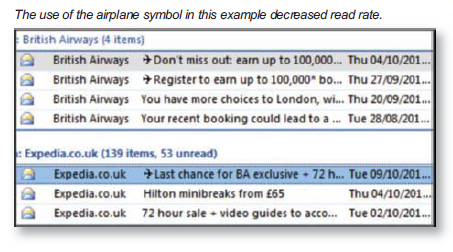Using Unicode Symbols in Email

PICTURE THIS: Can Using Unicode Symbols in Email Increase Engagement?
The subject line is an important variable in the success of email marketing campaigns, but most email marketers aren't aware of just how creative they can get.
In the last couple of years, savvy email senders have experimented with using special characters known as Unicode symbols (e.g. , òº , ô£ , ô¶ , ô´) as a way to stand out in crowded inboxes and differentiate their brands from their competition (and their own previous emails). After all, pictures tell a thousand words, right?
Today, anyone with an email account can see this trend's adoption is gaining speed, but are symbols for everyone?

"The experiments with Unicode symbols included in subject lines gets quite a large group of email marketers busy these days," said GetResponse Education Expert, Mack Gorski. "Along with popularity comes a concern whether using those symbols is safe and effective. The answer is quite simple. You never know until you try, or in regards to the email, until you test it."
Plenty of enterprises are testing this tactic. Return Path recently published a comparison of Expedia UK and British Airways' use of the airplane symbol in emails that were sent just a few days apart. According to Return Path, the "read rate," the degree at which subscribers read an email was approximately a quarter lower than their corresponding 90-day averages. There were no deliverability issues, however, and of course this does not take into account many factors that impact a campaign's metrics (list, time sent, type of offer, etc.), but Return Path noted that the decline in engagement was similar for both brands. Perhaps proving that the results of symbols in email subject lines is a mixed bag, Return Path also issued three examples of companies that used symbols in subject lines effectively and showed positive results (one even as high as 17 percent increase in click-through rates).
Interestingly, while British Airways and Expedia UK saw negative results from using the airplane symbol, Experian CheetahMail found that the greatest unique open rate lifts they've seen were in subject lines including umbrellas (50 percent) and airplanes (10.7 percent) In the same report, Experian CheetahMail saw mixedto- positive results from their study. For example, subject lines with symbols had a higher unique open rate in 56 of the brands analyzed. Notably, the black heart, which is the most popular symbol, provided only a modest open rate lift.
Confused as to whether symbols in email subject lines work or not? Don't be, like in all things digital, it really comes down to testing.
"If you won't experiment with the content of your messages, form of your subject or any other parts of the emails that you deliver to your audience, you'll be stuck with oneway communication," said Gorski. "In time, your emails will become out dated against the current trends and your subscribers may get bored seeing the same type of communication in their inboxes repeatedly."
It truly remains to be seen if adding symbols in subject lines enhance the user experience and furnish positive results for those willing to experiment, but the more companies that adopt this approach, the bigger risk it has of returning negative results.
"Consumers will ultimately decide whether symbols in subject lines help them understand and prioritize messages, but if they're voting with their feet today by engaging with those messages, it's probably an indication that they'll continue to, at least as long as the symbols add to their experience," said Return Path Sr. Director of Email Research, Tom Sather. "As with most trends though, if overused, it will lose its effectiveness."
ALSO READ: Will My Symbols Work?
Before you commit to testing symbols in an email subject line, check to see which email clients support them. Learn more.











